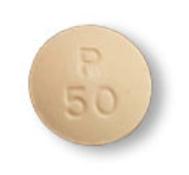Pyridoxine Dosage
Medically reviewed by Drugs.com. Last updated on Apr 25, 2025.
Applies to the following strengths: 25 mg; 50 mg; 100 mg; 100 mg/mL; pyridoxal 5'-phosphate 50 mg; (as pyridoxal 5'-phosphate)
Usual Adult Dose for:
Usual Pediatric Dose for:
Additional dosage information:
Usual Adult Dose for Drug Induced Vitamin/Mineral Deficiency
Isoniazid induced deficiencies: 100 mg intramuscularly or intravenously once a day followed by a 30 mg maintenance dose daily
Poisoning caused by ingestion of over 10 grams of isoniazid: Give an equal amount of pyridoxine, starting with 4 grams intravenously followed by 1 gram intramuscularly every 30 minutes
Usual Adult Dose for Dietary Supplement
Injectable:
Dietary deficiency: 10 to 20 mg intramuscularly or intravenously once a day for 3 weeks
- Follow up with an oral multivitamin containing 2 to 5 mg pyridoxine daily for several weeks.
- Correct poor dietary habits; prescribe a well balanced diet.
Recommended dietary allowance of vitamin B6:
18 years, male: 1.3 mg/day
18 years, female: 1.2 mg/day
19 to 50 years (both genders): 1.3 mg/day
51 to 70 years, male: 1.7 mg/day
51 to 70 years, female: 1.5 mg/day
Pregnancy: 1.9 mg/day
Lactation: 2 mg/day
Usual Adult Dose for Seizures
Injectable:
Vitamin B6 dependency syndrome: Up to 600 mg intramuscularly or intravenously daily, with a daily intake of 30 mg for life
Usual Pediatric Dose for Dietary Supplement
Adequate intake of vitamin B6:
0 to 6 months: 0.1 mg/day
7 to 12 months: 0.3 mg/day
Estimated adequate intake of vitamin B6:
1 to 3 years: 0.4 mg/day
4 to 8 years: 0.5 mg/day
9 to 13 years: 0.8 mg/day
14 to 18 years, male: 1.1 mg/day
14 to 18 years, female: 1 mg/day
Recommended dietary allowance of vitamin B6:
1 to 3 years: 0.5 mg/day
4 to 8 years: 0.6 mg/day
9 to 13 years: 1 mg/day
14 to 18 years, male: 1.3 mg/day
14 to 18 years, female: 1.2 mg/day
Renal Dose Adjustments
Data not available
Liver Dose Adjustments
Data not available
Dialysis
Data not available
More about pyridoxine
- Check interactions
- Compare alternatives
- Pricing & coupons
- Reviews (4)
- Drug images
- Side effects
- During pregnancy
- Drug class: vitamins
- En español
Patient resources
- Pyridoxine drug information
- Pyridoxine (Advanced Reading)
- Pyridoxine (Vitamin B6) Capsules and Tablets
- Pyridoxine (Vitamin B6) Extended-Release Tablets
- Pyridoxine (Vitamin B6) Injection
Other brands
Professional resources
Related treatment guides
See also:
Further information
Always consult your healthcare provider to ensure the information displayed on this page applies to your personal circumstances.


